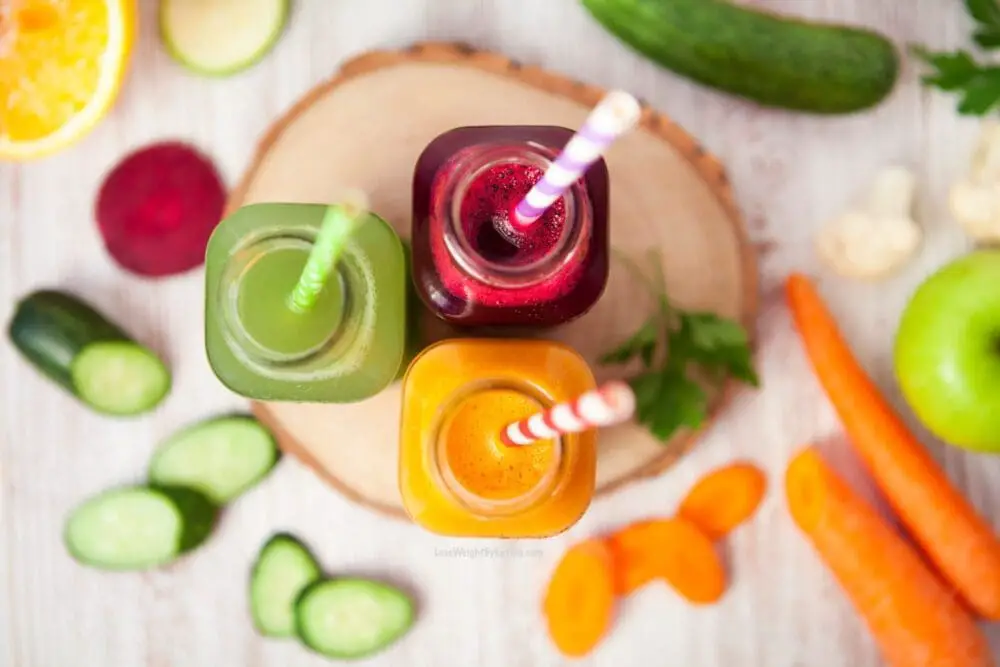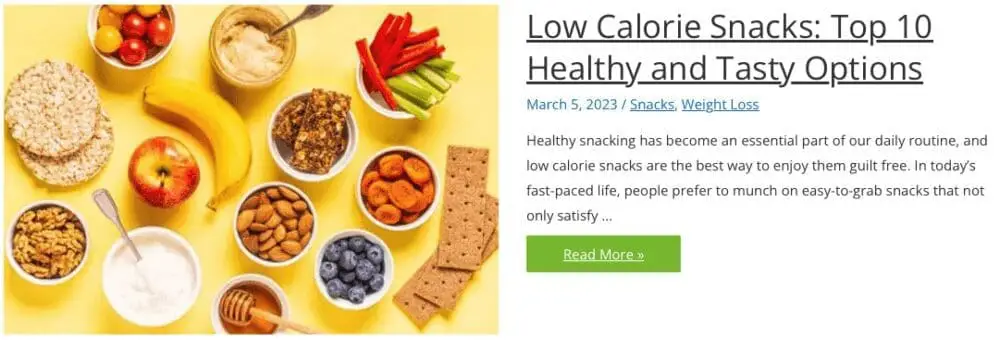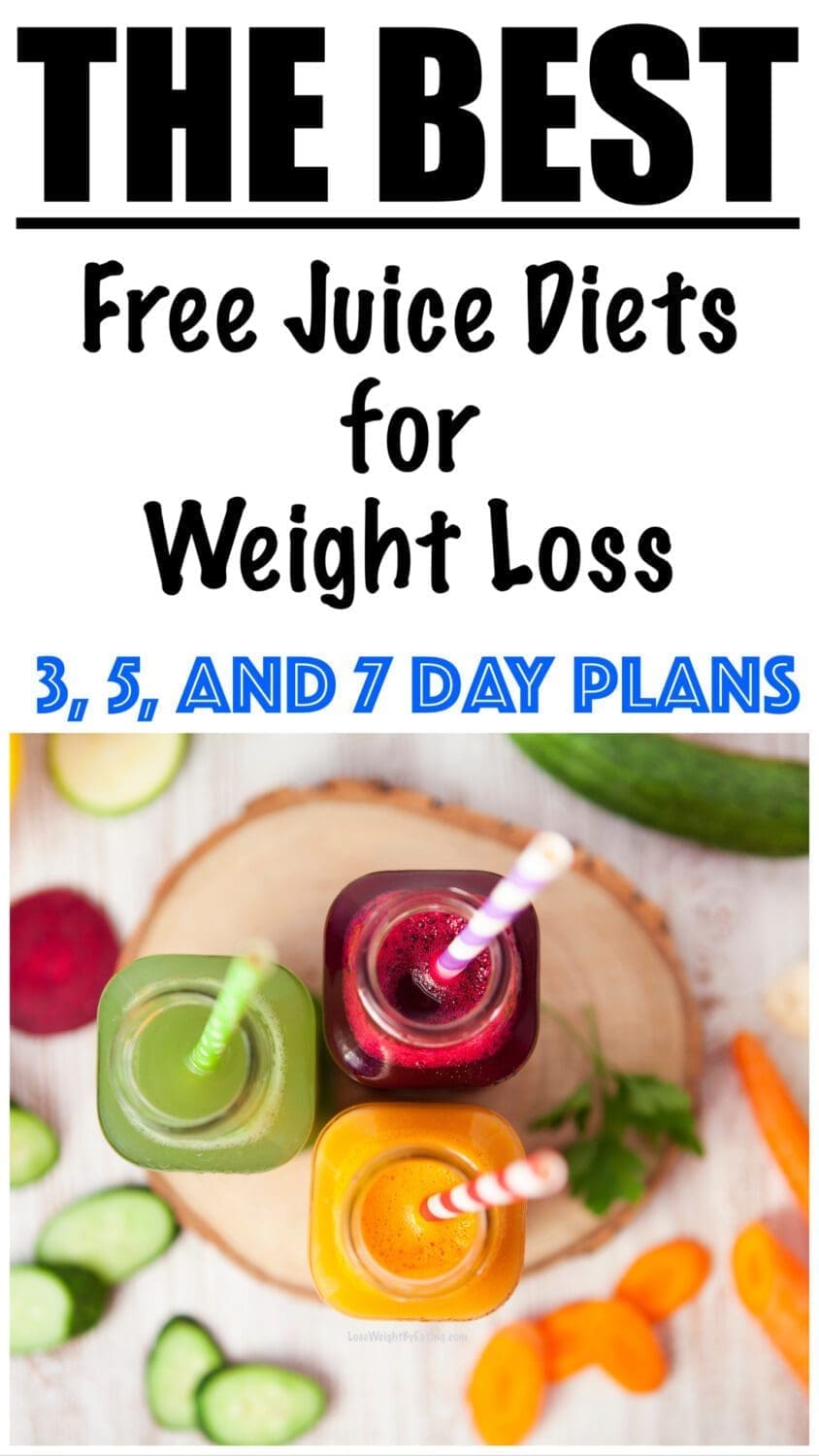Are you looking to detox your body and lose weight? A juice diet might be just what you need.
With a juice cleanse, you’ll replace your meals with fresh, nutrient-rich juices for a set period of time, typically 3, 5, or 7 days. This can help you eliminate toxins, improve digestion, and kickstart your weight loss journey.


In this complete guide to a juice diet, I’ll cover everything you need to know about 3, 5, and 7 day juice cleanses. From the benefits to the recipes, and from pros and cons, I’ve got you covered. So, let’s get started!
What Is Juice Fasting?
Juice fasting, also known as juice cleansing, is a type of detox diet that involves consuming only juices made from fruits and vegetables for a set period of time. The goal of juice fasting is to give your body a break from solid foods and provide it with essential vitamins and minerals in an easily digestible form.
Juice fasting can range from a few days to several weeks, depending on the individual’s goals and overall health. During a juice fast, it’s important to drink plenty of water and avoid consuming any solid food, including snacks and supplements.
While juice fasting can be an effective way to give your digestive system a break and increase nutrient intake, it’s important to approach it with caution. Juice fasting can result in rapid weight loss, but the weight loss may not be sustainable over the long term if you go back to bad eating habits after it’s over.
Additionally, juice fasting can be low in protein, healthy fats, and fiber, which are important for overall health and wellness. Without these nutrients, you may feel hungry, weak, and struggle to maintain your energy levels. If you are concerned about this, a Smoothie Diet might be better for your specific needs.
If you’re considering juice fasting, it’s important to consult with a healthcare professional first. They can help you determine if juice fasting is appropriate for your individual health needs and provide guidance on how to approach it safely.
Juice fasting is a type of detox diet that involves consuming only juices made from fruits and vegetables for a set period of time. While it can be an effective way to increase nutrient intake and give your digestive system a break, it’s important to approach it with caution and under the guidance of a healthcare professional.
Can You Lose Weight by Juicing?
Juicing has become a popular trend for weight loss in recent years. While it’s true that a juice cleanse can help you lose weight quickly, it’s important to understand that the weight loss may not be sustainable over the long term unless you start a Healthy Diet as soon as it ends.
During a juice detox, you consume mostly fruits and vegetables, which are low in calories but high in essential vitamins and minerals. This can lead to a significant calorie deficit, which can result in weight loss.
However, once you resume your normal eating habits after the cleanse, it’s likely that you’ll regain some or all of the weight you lost during the juice cleanse. So it is important that you have a plan for after the juice cleanse ends. I have you covered with this weight loss meal plan!
That being said, incorporating juices into your regular diet can be a healthy and sustainable way to lose weight. By replacing high-calorie snacks and meals with nutrient-dense juices, you can reduce your overall calorie intake and support healthy weight loss.
It’s important to remember that weight loss is a gradual process that requires sustainable changes to your diet and lifestyle. While a juice cleanse can kickstart your weight loss journey, it’s important to focus on long-term, sustainable changes to your diet and lifestyle to achieve lasting results.
Is a Juice Cleanse a Healthy Choice for You?
Juice cleanses have become a popular trend for weight loss and detoxification, but are they a healthy choice for everyone? The answer depends on your individual health status and goals.
For most healthy individuals, a short-term juice cleanse can be a healthy way to increase nutrient intake and give your digestive system a break. However, it’s important to choose high-quality produce and juices that are free from added sugars and preservatives.
If you have underlying health conditions or are taking medications, it’s important to consult with a healthcare professional before starting a juice cleanse. Certain health conditions may require modifications to a juice cleanse or make it unsafe for you to participate.
Additionally, juice cleanses should not be used as a long-term solution for weight loss or as a replacement for a balanced and varied diet. While a juice cleanse can result in rapid weight loss, the weight loss may not be sustainable over the long term and can lead to nutrient deficiencies.
A juice cleanse can be a healthy choice for most individuals when done properly and under the guidance of a healthcare professional. It’s important to approach a juice cleanse with caution, choose high-quality juices and produce, and not rely on it as a long-term solution for weight loss or as a replacement for a balanced diet.
The Benefits of a Juice Detox Diet:
Before we dive into the details of a juice diet, let’s take a look at some of the benefits:
- Detoxification: A juice cleanse can help you eliminate toxins from your body and improve your overall health.
- Improved Digestion: Juices are rich in enzymes that can improve your digestion and reduce bloating.
- Weight Loss: A juice diet can help you shed some extra pounds and kickstart your weight loss journey.
- Increased Energy: Juices are full of nutrients that can boost your energy levels and keep you feeling refreshed throughout the day.
- Better Skin: The vitamins and minerals in juices can help improve your skin’s appearance and give you a healthy glow.
Now that we’ve covered some of the benefits, let’s move on to the details of a juice diet.
3 Day Juice Cleanse:
As with all 3 of these juice diets, you will replace your 3 meals a day, with 6 juices per day. I have you covered with lots of nutrient packed juice cleanse recipes below!
If you’re new to juice cleansing, a 3 day cleanse is a great place to start. Here’s what you’ll need to do:
- Choose your juices: You’ll need to select 6 juices per day – 3 fruit-based and 3 vegetable-based.
- Drink plenty of water: It’s important to stay hydrated during your cleanse, so make sure you drink plenty of water throughout the day.
- Avoid solid foods: You’ll need to avoid solid foods during your cleanse, so stick to your juices and water.
- Rest: It’s important to give your body plenty of rest during your cleanse, so try to avoid strenuous activities.
- Listen to your body: If you’re feeling hungry or tired, don’t hesitate to adjust your cleanse as needed.
5 Day Juice Cleanse:
Just like the 3 day juice diet, you will want to replace your typical 3 meals a day, with 6 juices per day. See below for some healthy nutrient dense juice cleanse recipes!
If you’re looking for a longer cleanse, a 5 day juice cleanse might be a better option for you. Here’s what you’ll need to do:
- Choose your juices: You’ll need to select 6 juices per day – 3 fruit-based and 3 vegetable-based.
- Drink plenty of water: It’s important to stay hydrated during your cleanse, so make sure you drink plenty of water throughout the day.
- Avoid solid foods: You’ll need to avoid solid foods during your cleanse, so stick to your juices and water.
- Rest: It’s important to give your body plenty of rest during your cleanse, so try to avoid strenuous activities.
- Listen to your body: If you’re feeling hungry or tired, don’t hesitate to adjust your cleanse as needed.
7 Day Juice Cleanse:
As noted in the other two juice diets, you will want to replace your 3 meals per day with 6 juices per day. I have supplied lots of healthy juice recipes in the next section.
If you’re ready for a longer cleanse, a 7 day juice cleanse might be the right choice for you. Here’s what you’ll need to do:
- Choose your juices: You’ll need to select 6 juices per day – 3 fruit-based and 3 vegetable-based.
- Drink plenty of water: It’s important to stay hydrated during your cleanse, so make sure you drink plenty of water throughout the day.
- Avoid solid foods: You’ll need to avoid solid foods during your cleanse, so stick to your juices and water.
- Rest: It’s important to give your body plenty of rest during your cleanse, so try to avoid strenuous activities.
- Listen to your body: If you’re feeling hungry or tired, don’t hesitate to adjust your cleanse as needed.
Juice Cleanse Recipes:
Now that you know how to do a juice cleanse, let’s take a look at some delicious and nutritious juice recipes to get you started:
- Green Juice: Kale, spinach, cucumber, apple, lemon, and ginger.
- Beet Juice: Beets, carrots, apple, ginger, and lemon.
- Carrot Juice: Carrots, apple, ginger, and turmeric.
- Citrus Juice: Orange, grapefruit, lemon, and lime.
- Pineapple Juice: Pineapple, cucumber, spinach, and mint.
How to Make Juice in a Blender or a Juicer
There are two main ways to make juice – using a juicer or a blender. Here’s how to make juice using both methods:
Using a Juicer:
- Choose your produce: Select your fruits and vegetables based on your taste preferences and nutritional goals.
- Wash and prep your produce: Wash your produce thoroughly and cut it into small pieces that will fit into the juicer.
- Juice your produce: Feed the produce into the juicer and collect the juice in a container. Most juicers will separate the pulp from the juice.
- Serve and enjoy: Pour the juice into a glass and enjoy immediately for optimal freshness and flavor.
Using a Blender:
- Choose your produce: Select your fruits and vegetables based on your taste preferences and nutritional goals.
- Wash and prep your produce: Wash your produce thoroughly and cut it into small pieces that will fit into the blender.
- Add liquid: Add about 1 cup of liquid, such as water or coconut water, to help blend the produce.
- Blend the produce: Blend the produce on high speed until it’s fully blended and smooth.
- Strain the juice: Pour the blended mixture through a fine mesh strainer to separate the juice from the pulp.
- Serve and enjoy: Pour the juice into a glass and enjoy immediately for optimal freshness and flavor.
Juicing with a juicer typically results in a smoother, pulp-free juice, while blending in a blender can create a thicker, pulpier juice. Both methods have their own advantages and disadvantages, so it’s up to personal preference to choose which method works best for you.
Regardless of which method you choose, be sure to choose fresh and high-quality produce, wash it thoroughly, and enjoy your homemade juice immediately for the best taste and nutrition.
Pros and Cons of a Juice Detox Diet
There are both pros and cons to a juice cleanse, and I wouldn’t really be helping you in this journey if I didn’t share both with you upfront. Remember, if this seams too difficult you can always try a 3 day or 7 day smoothie diet instead!
Pros:
- Improved Digestion: Juicing helps to remove toxins from your body and can improve your digestion by giving your digestive system a break from solid foods.
- Nutrient Boost: Juices can provide you with a quick and easy way to get a variety of essential nutrients, vitamins, and minerals that you might not otherwise consume in your regular diet.
- Weight Loss: A juice cleanse can help jumpstart your weight loss journey by reducing your calorie intake and promoting healthier eating habits.
- Hydration: Juices can help keep you hydrated throughout the day, which is important for overall health and well-being.
Cons:
- Limited Nutrients: While juices can provide you with a quick nutrient boost, they are often low in protein and healthy fats, which are essential for optimal health. I recommend starting with a 3 day juice diet and see how you feel before moving on to a 5 or 7 days diet.
- Caloric Restriction: Juice cleanses can be extremely low in calories, which can lead to fatigue, dizziness, and other side effects. This is why many people prefer smoothies. If you are concerned, a smoothie diet is a great option for you.
- Expensive: Juicing can be expensive, as fresh produce can be costly, and purchasing pre-made juices can add up quickly.
- Unsustainable: Juice cleanses are often short-term solutions and can be difficult to sustain over the long term, making it challenging to maintain weight loss or other health benefits. So be sure you have a plan for when it ends, this weight loss meal plan can help you!
Overall, a juice diet can be a beneficial addition to a healthy lifestyle, but it’s important to consider the pros and cons before embarking on a juice cleanse.
Frequently Asked Questions (FAQ)
It’s best to avoid strenuous activities during a juice cleanse, but light exercise like yoga or walking is okay.
It’s best to avoid caffeine during a juice cleanse, but if you can’t do without it, limit your intake to one cup per day.
Start with light, easily digestible foods like soup or salad, and gradually add in more solid foods over the next few days.
Final Thoughts on Juice Cleanses
A juice diet can be a great way to detox your body, improve your digestion, and kickstart your weight loss journey.
Whether you’re doing a 3, 5, or 7 day juice cleanse, make sure to choose nutrient-rich juices, drink plenty of water, and listen to your body.
With the delicious and nutritious juice recipes I’ve provided, you’ll be on your way to a healthier and happier you in no time. Cheers to The Complete Guide to a Juice Diet – 3, 5, and 7 Day Juice Cleanses!
What to Read Next:






Lose Weight By Eating Cookbooks


Share this Weight Loss Article:



